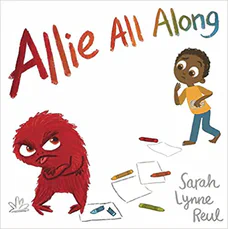Allie All Along

Recommended Age Range: Preschool through Kindergarten.
Publisher's Summary:
Have you ever felt mad enough to stomp, smash, and crash? Allie has! Meet one angry little girl and see how she calms down, bit by bit—with the help of her understanding big brother.

Dr. Annie's Takeaways
Recommended for: This book is a good introduction to anger management strategies for young children. An older brother helps his younger sister to calm down from a tantrum by coaching her through different coping skills. The book doesn’t ask that a child be able to identify their thoughts or feelings or what triggered the anger outburst; rather it non-judgmentally walks a child through a series of concrete skills to use to get back to feeling like themselves (e.g., squeezing a stuffed animal, pretending to blow out candles, counting backwards from 10).
Would a child like it? Many young children will enjoy this step-by-step guide for soothing their anger with the help of a loved one. Even if they don’t strictly enjoy it, they’ll likely find it palatable, and their grown-ups will find it useful.
Tone: Emotionally vibrant, compassionate
Story Quality: This is a sweet story about an older brother helping his little sister to manage her anger after her crayon breaks. The siblings’ relationship is very cute. As the boy walks his “furious, fuming, frustrated” sister through different calming strategies, she gets increasingly less mad, and she goes from being a red monster, to a calmer yellow one, then green, then blue, and finally back to being a little girl.
Illustrations: Cute, expressive illustrations that effectively use color to illustrate the process of Allie calming down.
Representation: Allie is a Black girl who spends most of the book as a monster. Her older brother named Micah (according to the author’s read-aloud; he’s unnamed in the story) is a Black boy.
Psychological Practices: Micah coaches Allie to calm her anger by squeezing a toy, taking a deep breath and blowing out pretend candles (he holds up his fingers as pretend candles), and counting backwards from 10. As she does each of these things, she calms a bit and changes to a new color (for therapists, this could line up well with a discussion of a “feelings thermometer”). It’s a nice visual representation of how we often need to use more than one coping strategy to return to a place of calm. By the end of the book, she has turned back into Allie and asks her brother for a hug. Older brother Micah is calm and understanding for the whole book, and he makes these anger management skills look mature and almost cool.
Concerns: The first thing that Micah encourages Allie to do is punch a pillow “so she wouldn’t break other stuff.” It is presented as helping her to start to calm down (she turns from red to yellow). Although punching a pillow is certainly better than breaking things, aggressive strategies like this don’t often help a child to calm down and can even make them feel angrier. When a child is regularly punching/kicking/hitting in a way that could hurt them or someone else, punching a pillow can be an interim step toward a child developing more effective coping skills, but it shouldn’t be considered a long-term anger management solution.
